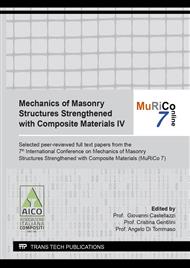p.239
p.249
p.256
p.267
p.275
p.283
p.289
p.297
p.305
Experimental Investigation on Flexural Performance of Masonry Wallettes Strengthened with Cementitious Matrix Grid
Abstract:
A large experimental study was conducted at IIT Patna, India to evaluate the effectiveness of different types of cementitious matrix grids (CMGs) in improving the flexural performance of unreinforced masonry specimens. Four types of masonry wallettes: brick-lime mortar, brick-cement mortar, brick-mud mortar and autoclaved aerated concrete (AAC) block masonry were prepared in the laboratory. In this study, eleven different CMG comprising of glass fabric and steel wire meshes embedded in the five different grades of cementitious matrix were used to strengthen the masonry assemblages. The aim of this study is to understand the role of various parameters such as tensile strength of CMG, compressive strength of masonry and cementitious matrix in influencing the efficiency of the strengthening scheme. In total 130 specimens with failure plane-parallel and perpendicular to the bed joint were prepared and tested under quasi-static displacement control loading. Considering the ease of installation, the fabric was directly placed on the masonry wallette using mechanical anchors and then covered with a thick layer of cementitious matrix.Test results highlights that all strengthening schemes are effective and can significantly enhance the flexural moment capacity in the range of 2.5 - 63.0 times the flexural moment of the respective control specimens. These strengthening schemes effectively mitigate the brittle behaviour of masonry wallettes and improved the deformation capacity by 1.2 - 18.1 times when compared to the respective control specimens. The study also illustrated that the strength of cementitious matrix can play an important role in contributing to the strength and deformability of the masonry specimens strengthened with CMG. For low strength cementitious matrix, debonding failure was commonly observed, whereas, for high strength cementitious matrix, the failure/rupture of reinforcement was noticed. In addition, the shear failure of masonry or debonding failure of reinforcing mesh was observed for specimens in which CMG had higher percentage of reinforcement.
Info:
Periodical:
Pages:
275-282
Citation:
Online since:
April 2022
Authors:
Price:
Сopyright:
© 2022 Trans Tech Publications Ltd. All Rights Reserved
Share:
Citation:


